
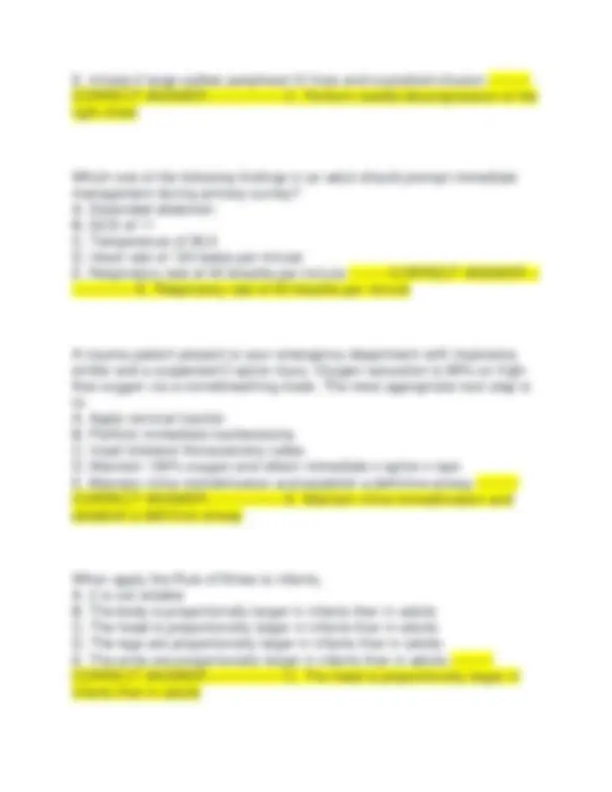
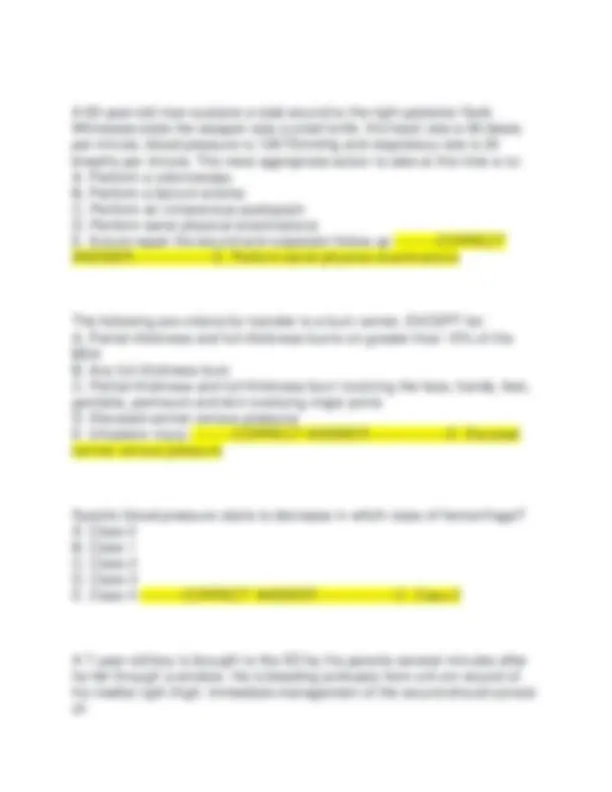
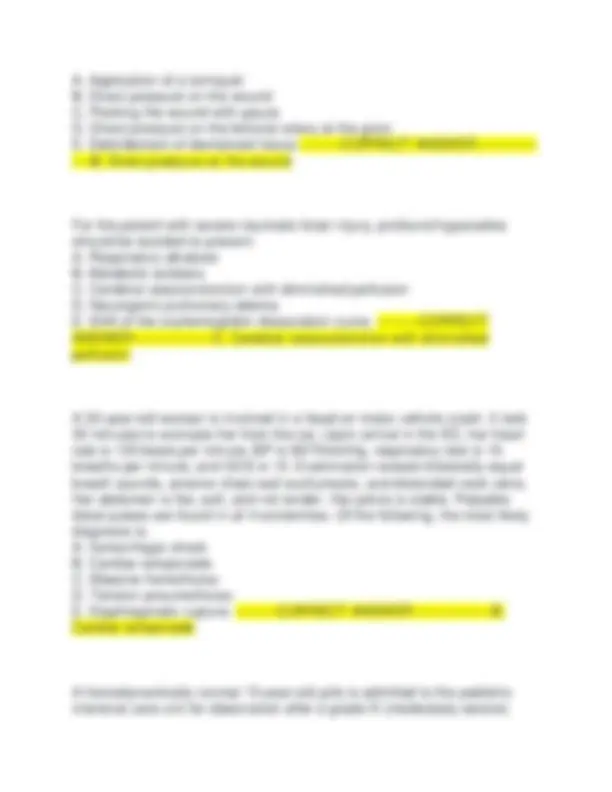
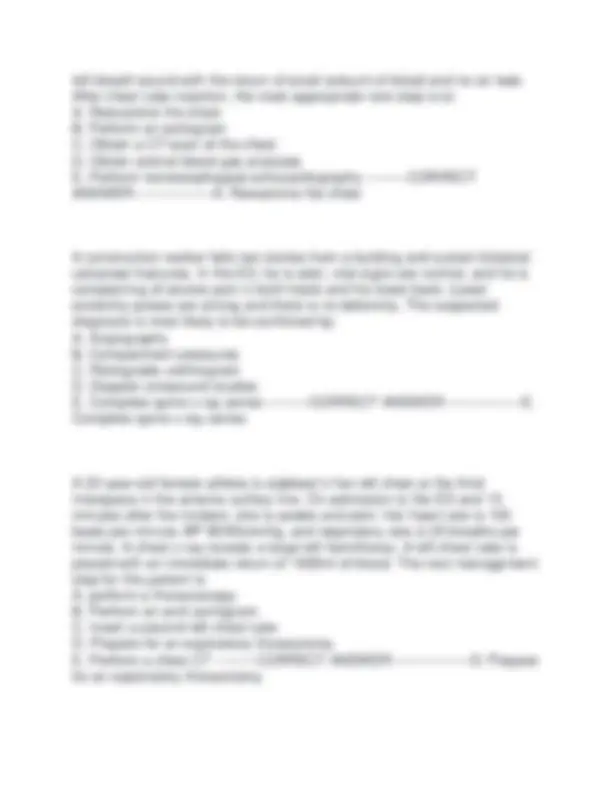
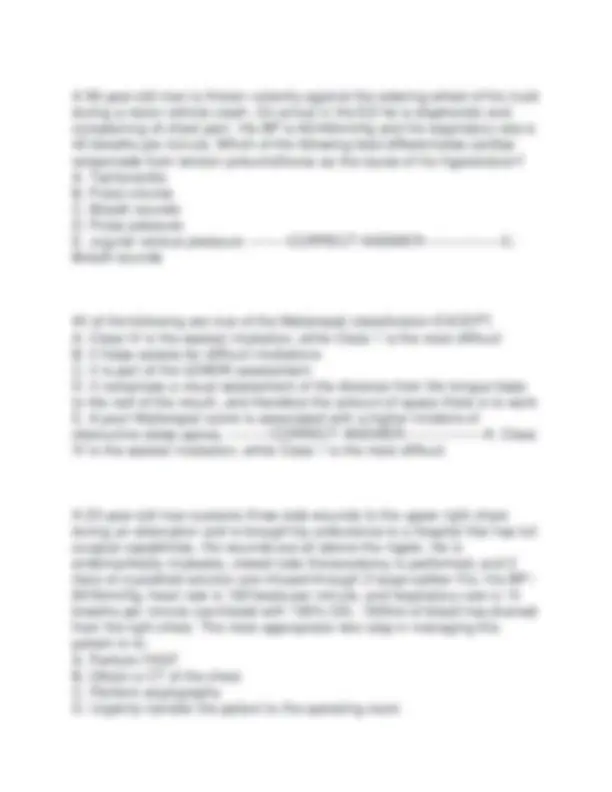
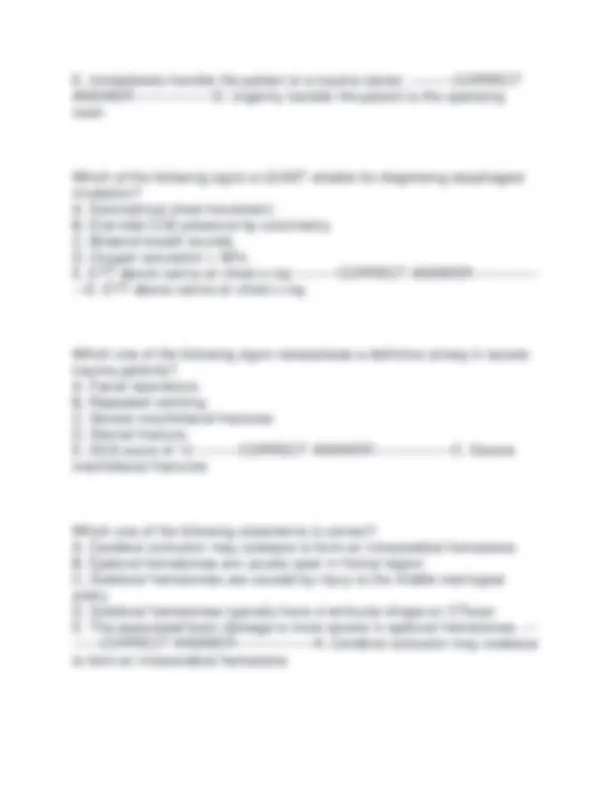
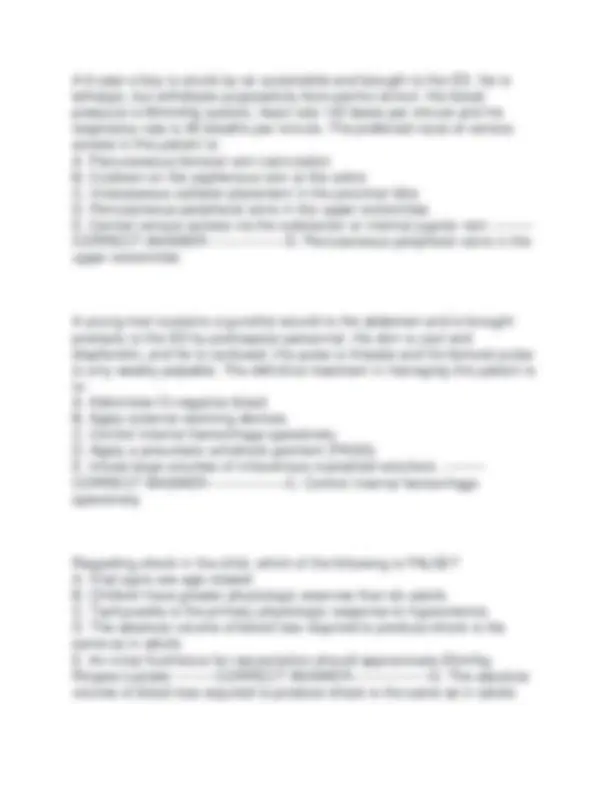
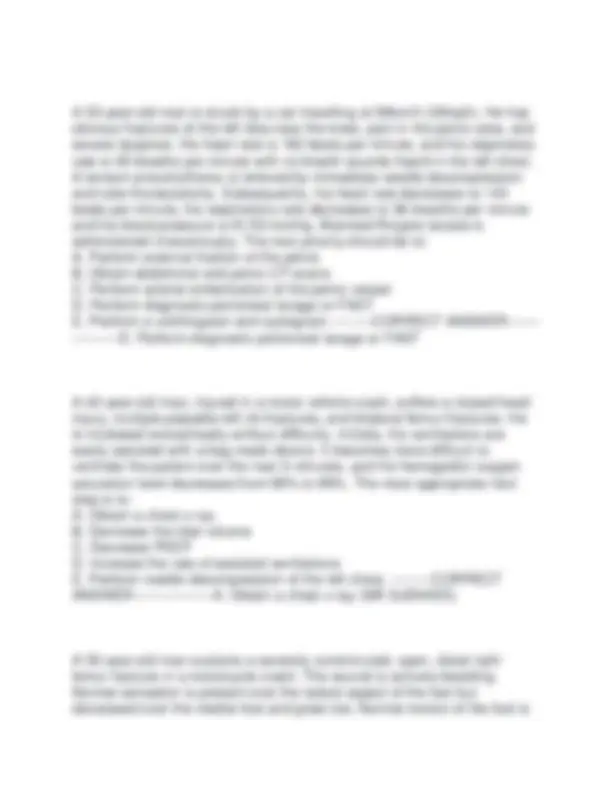
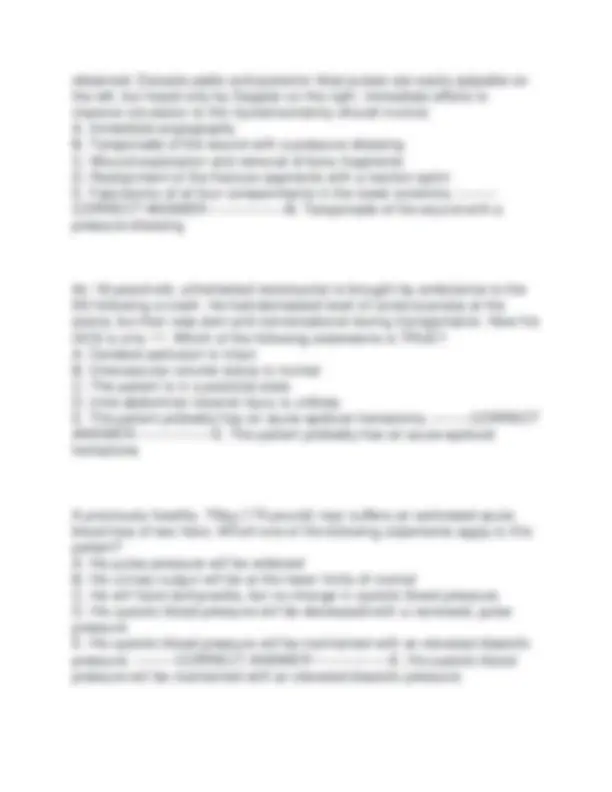
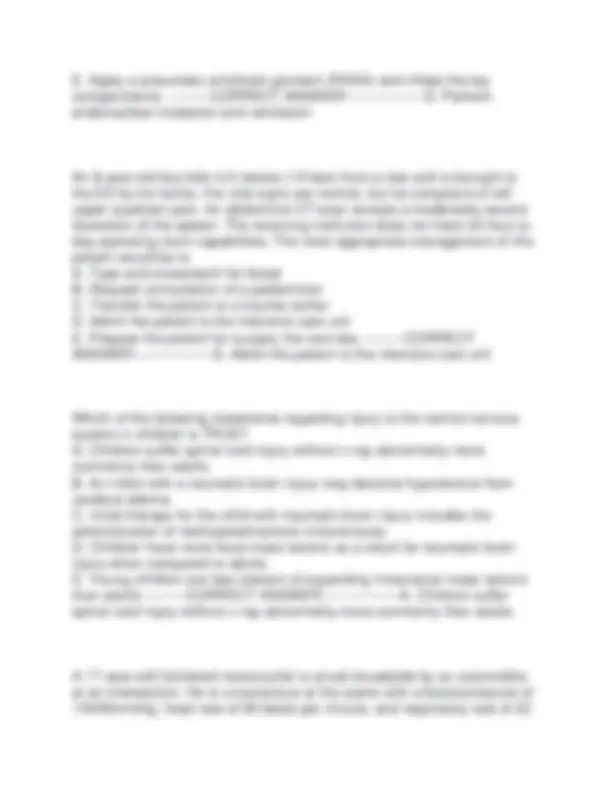
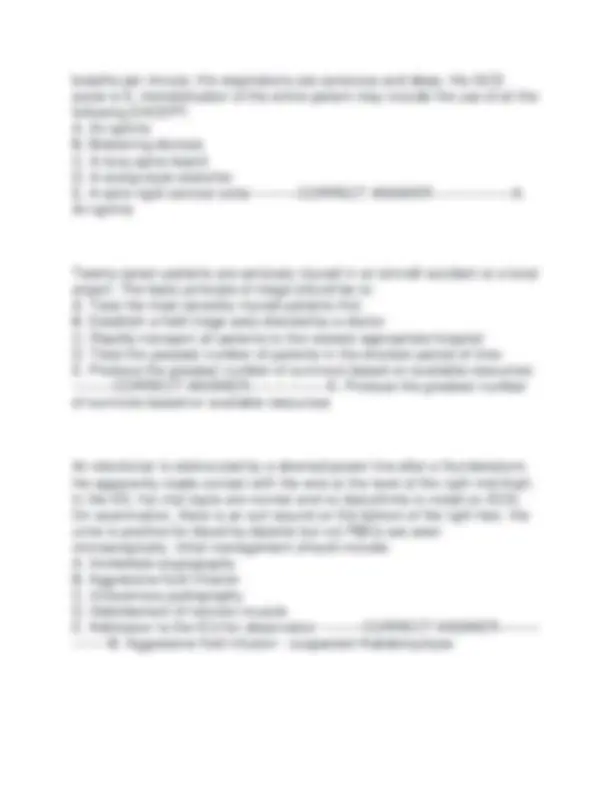
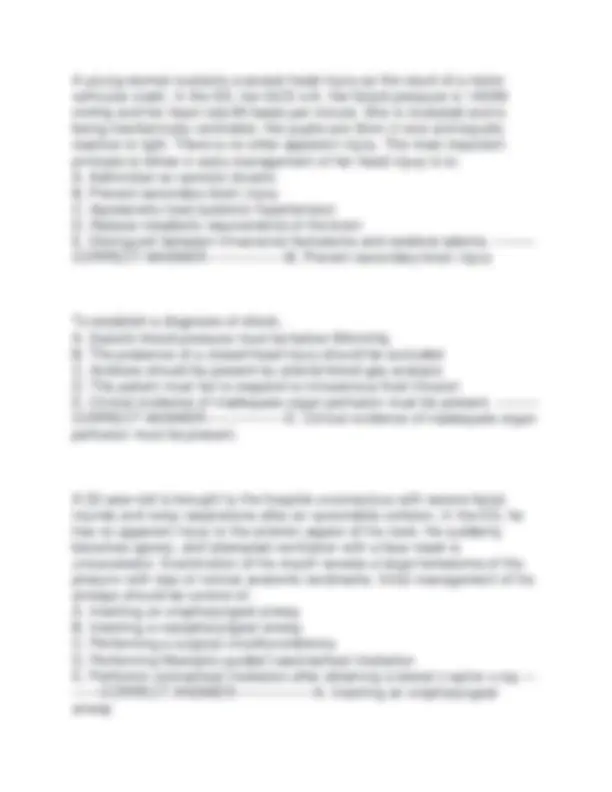
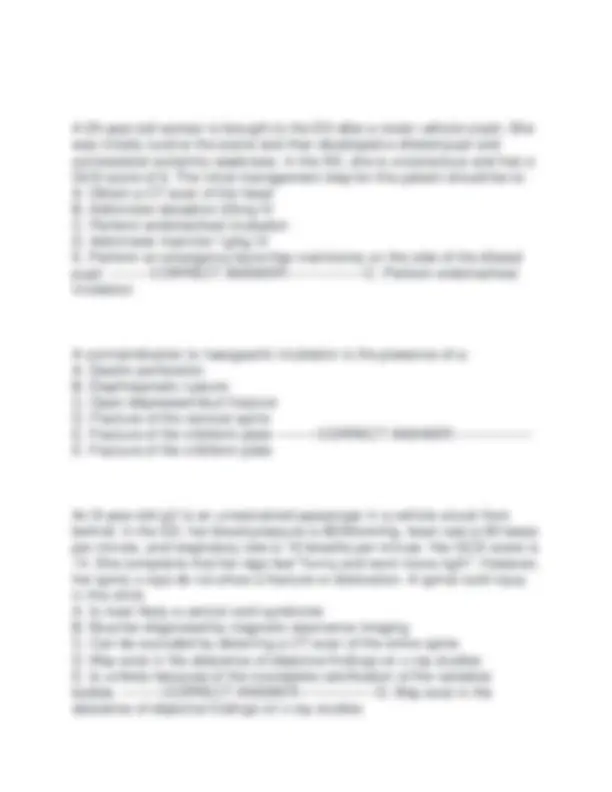
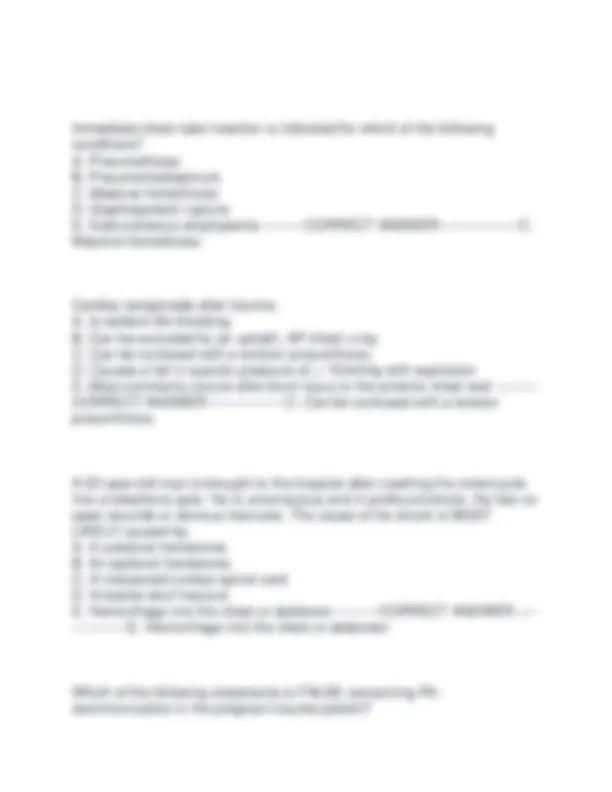
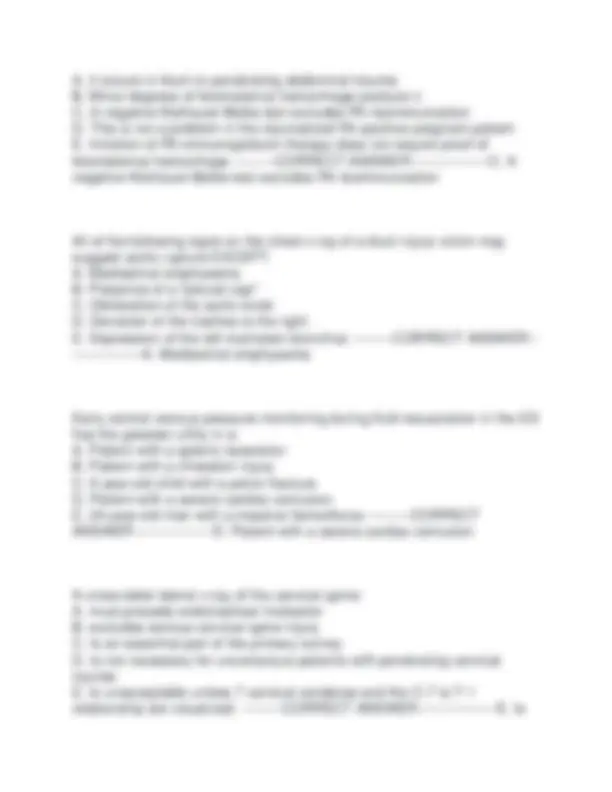
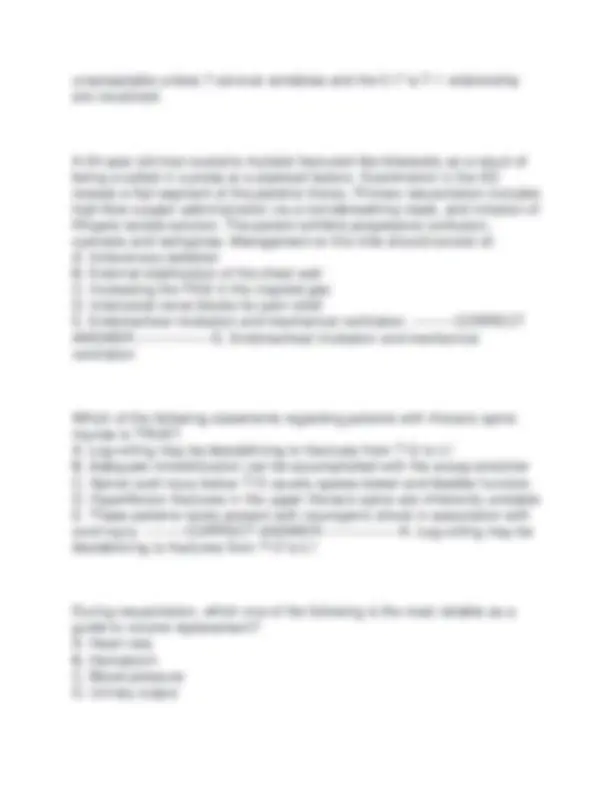
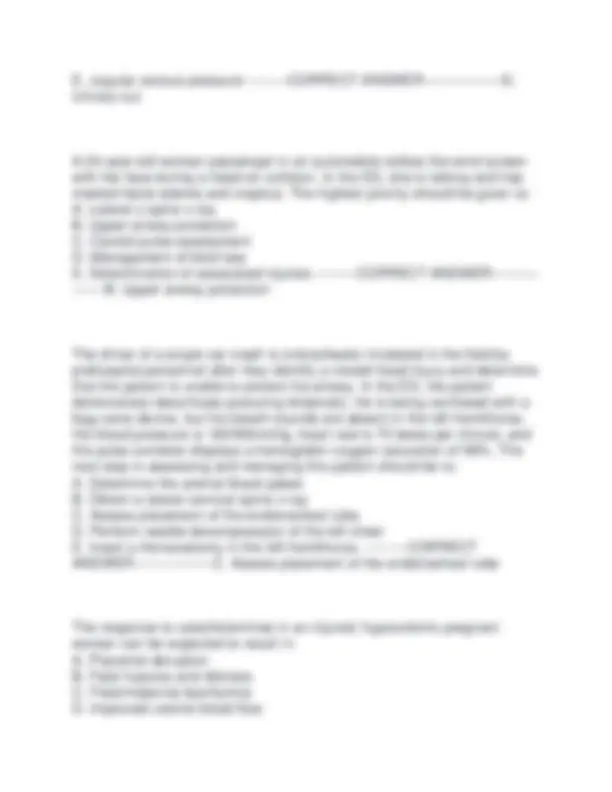
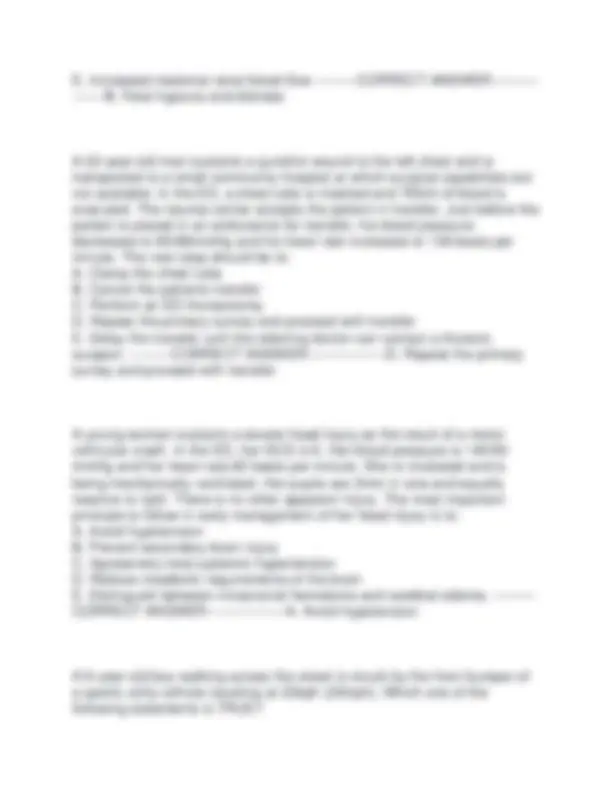
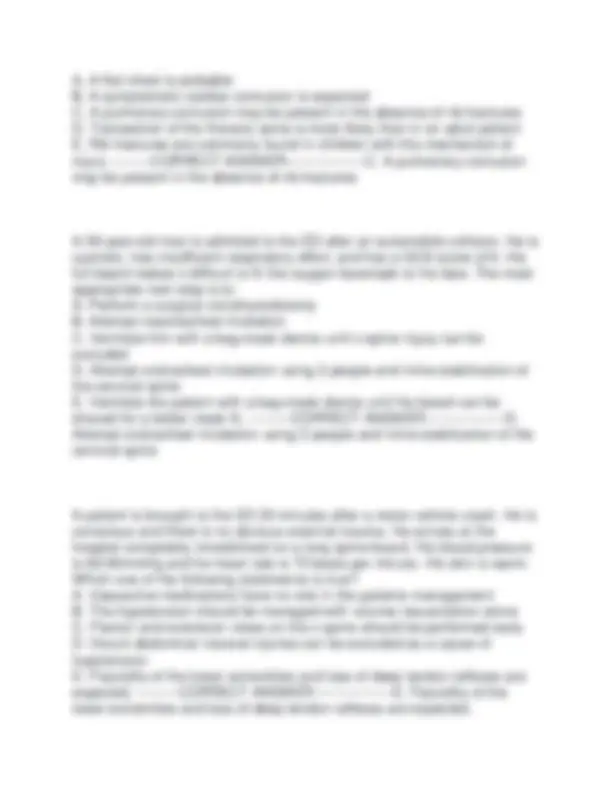
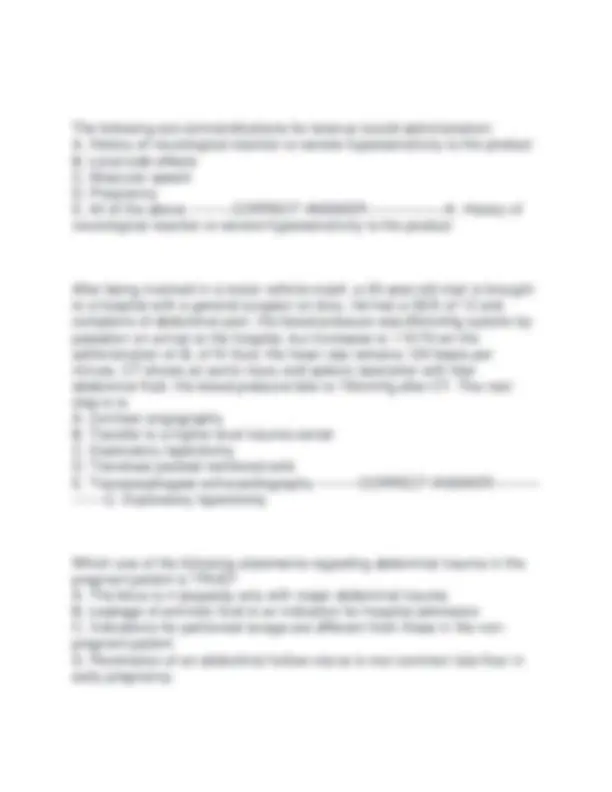
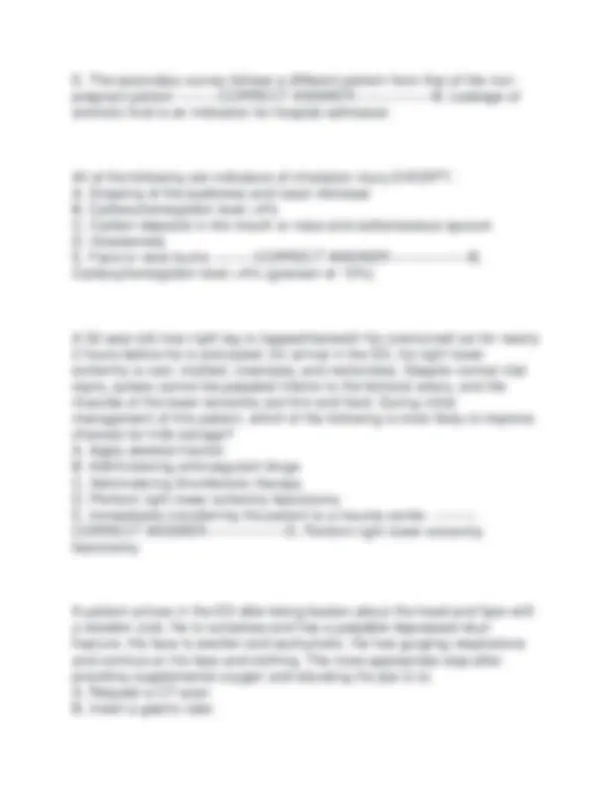
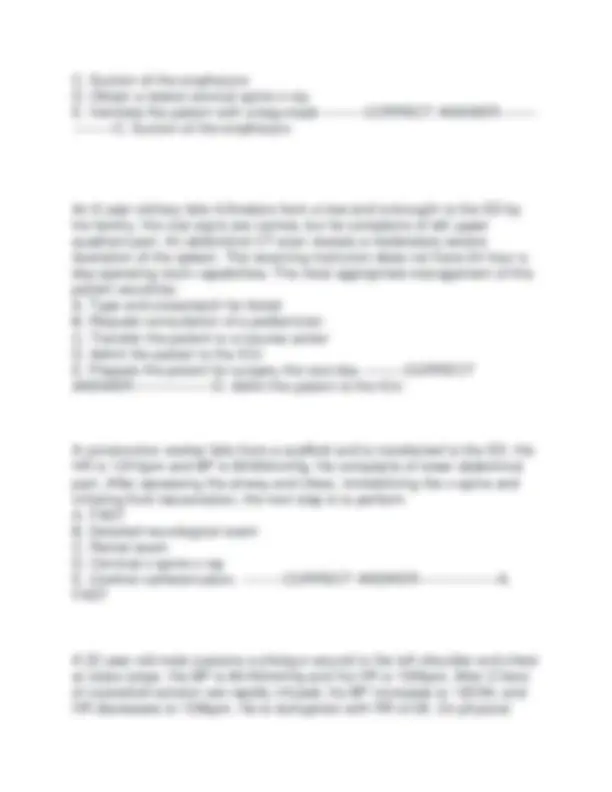
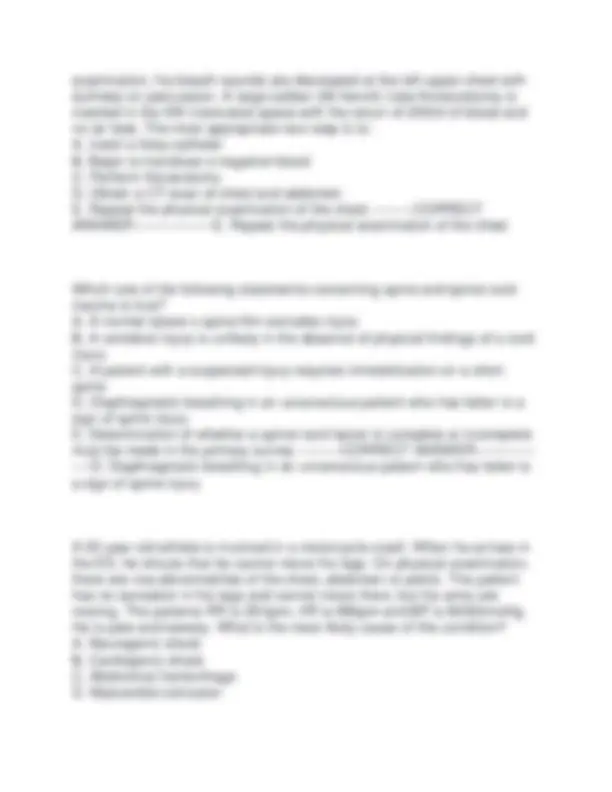
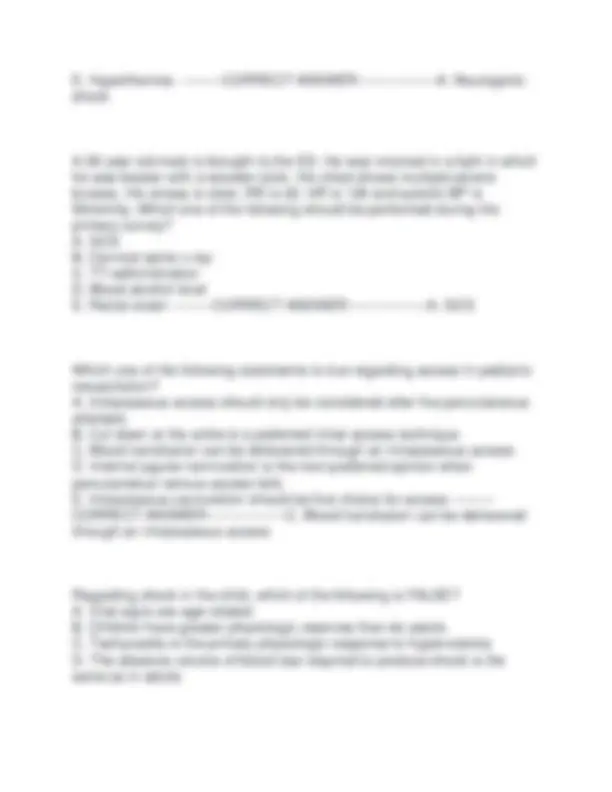
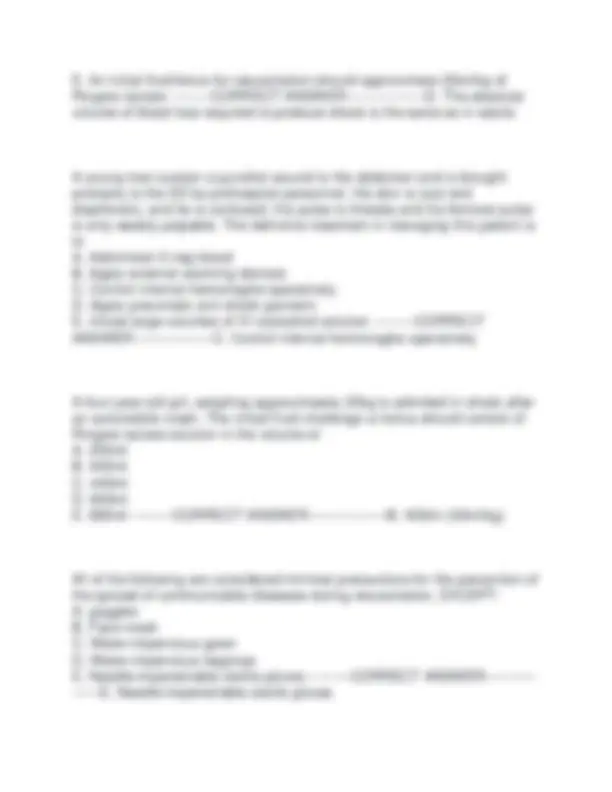
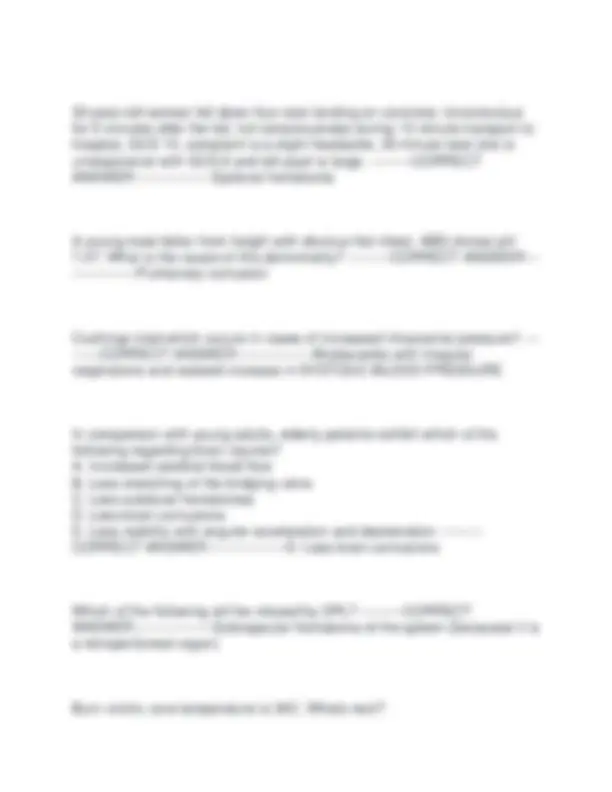
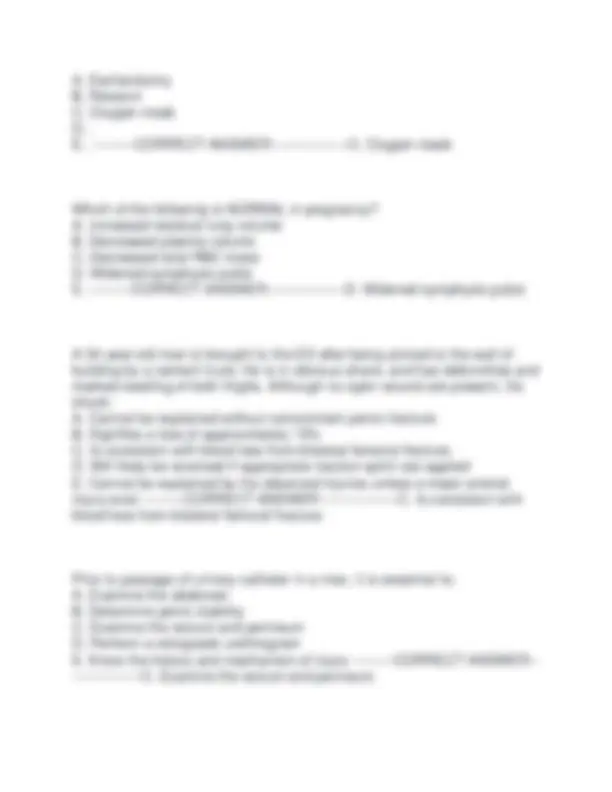
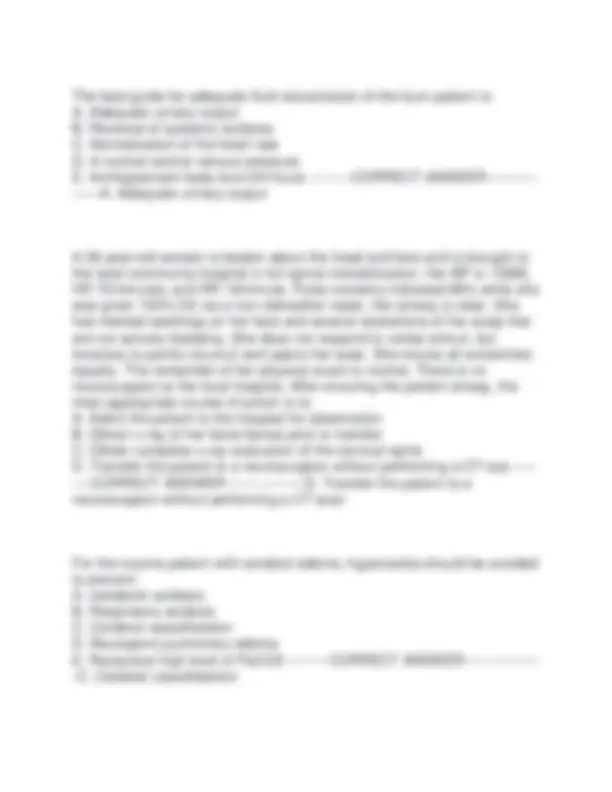
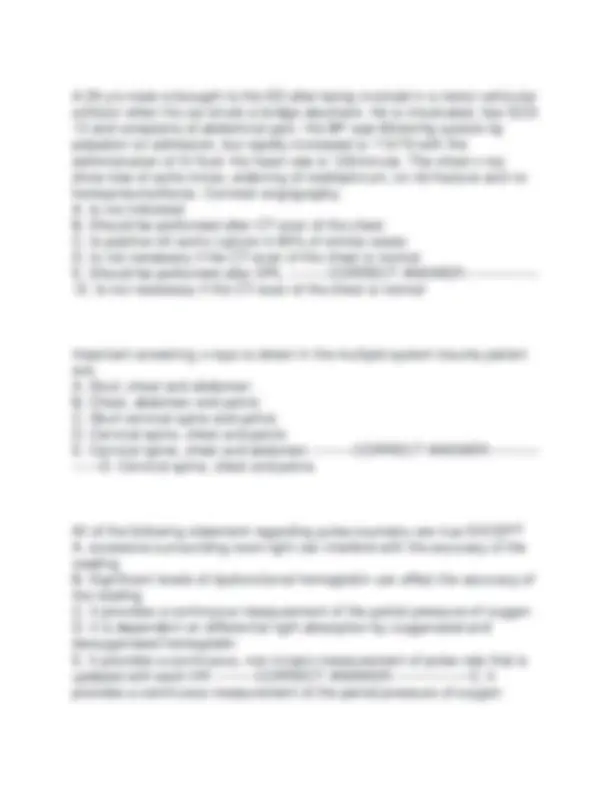
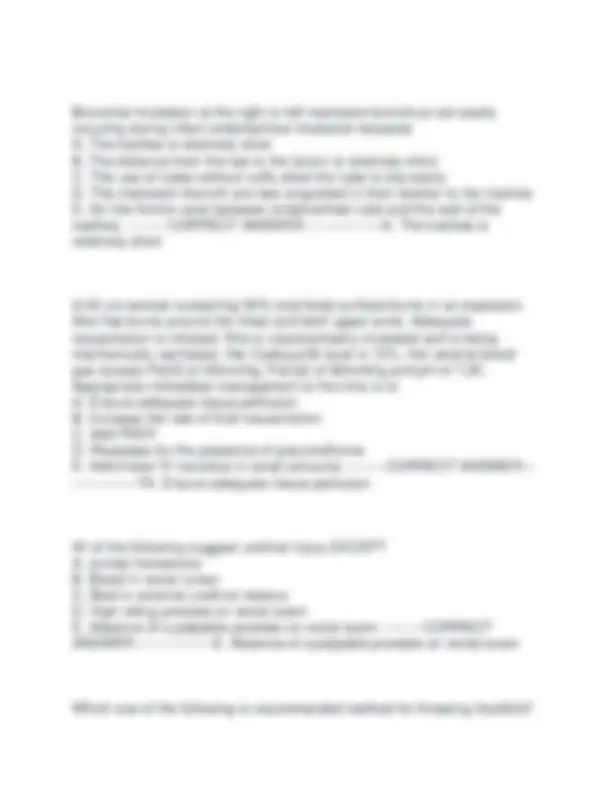
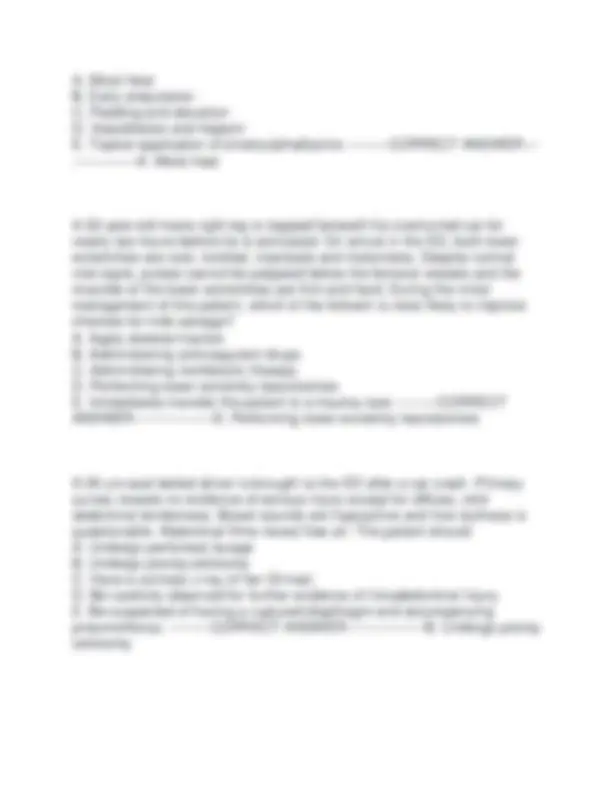
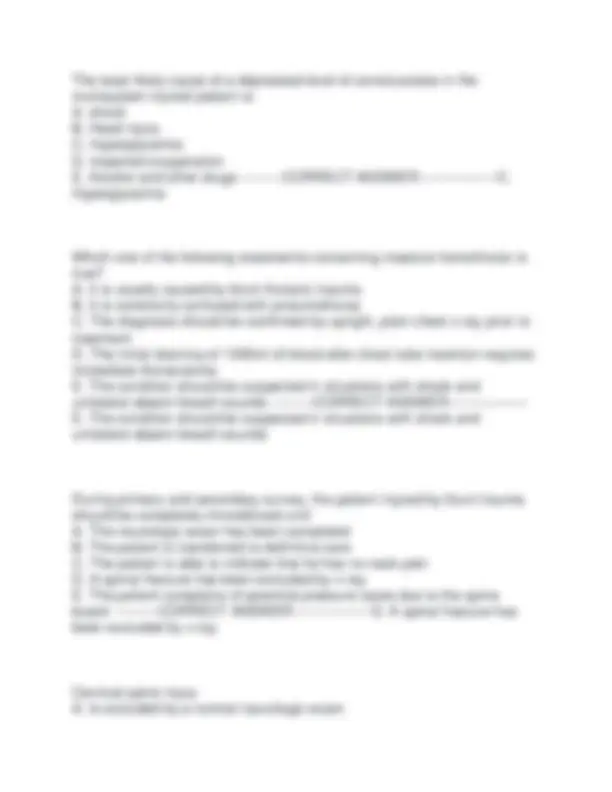
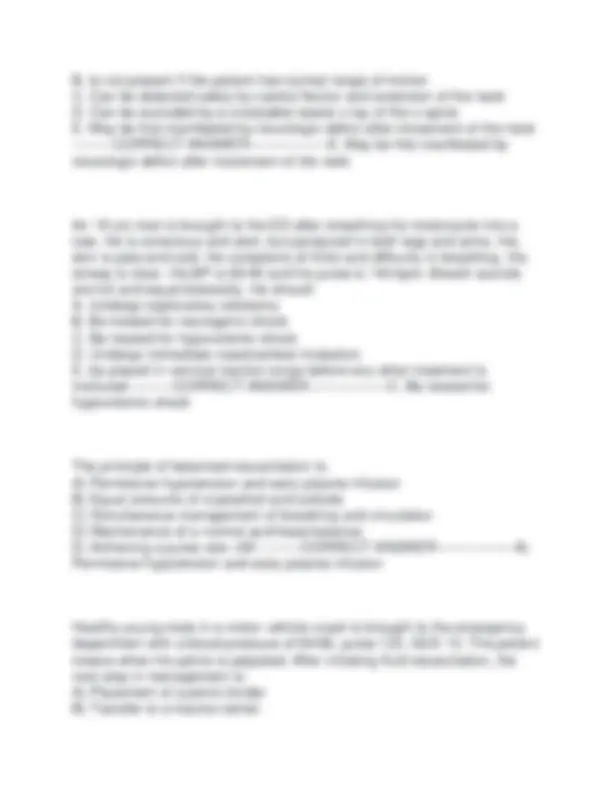
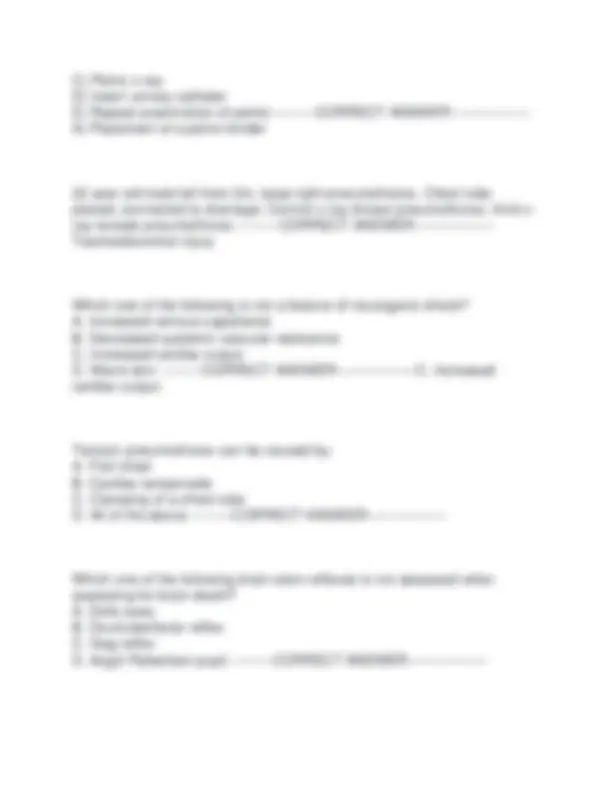
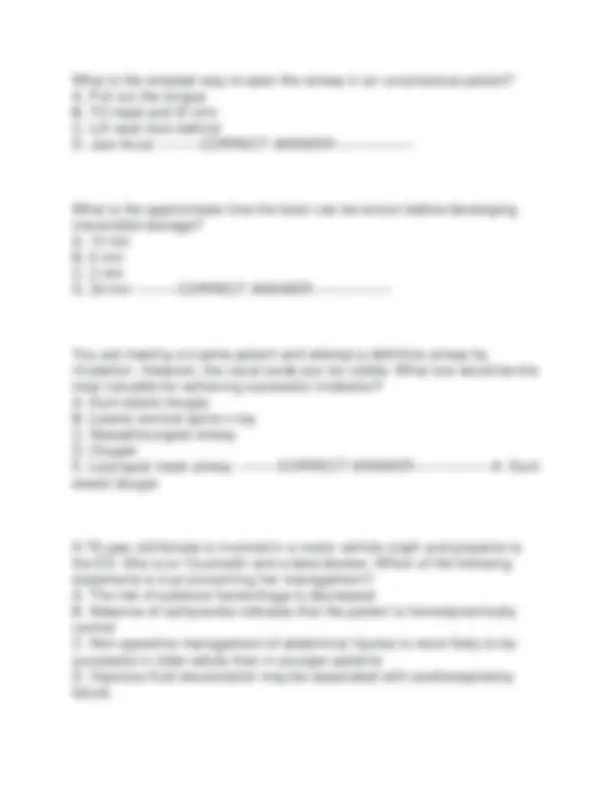
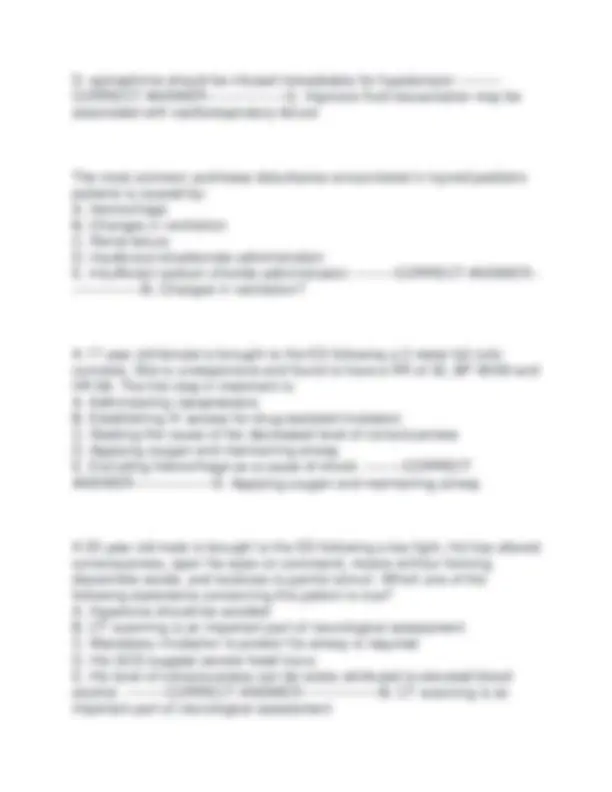
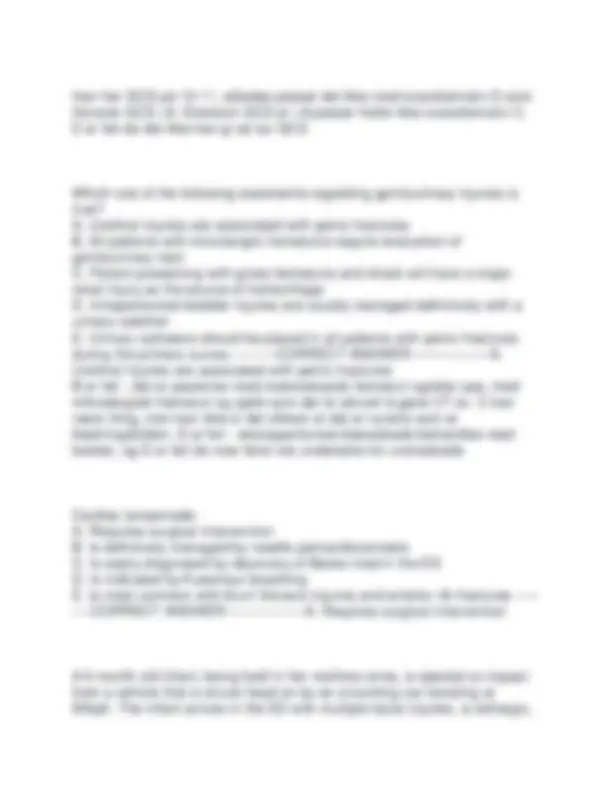
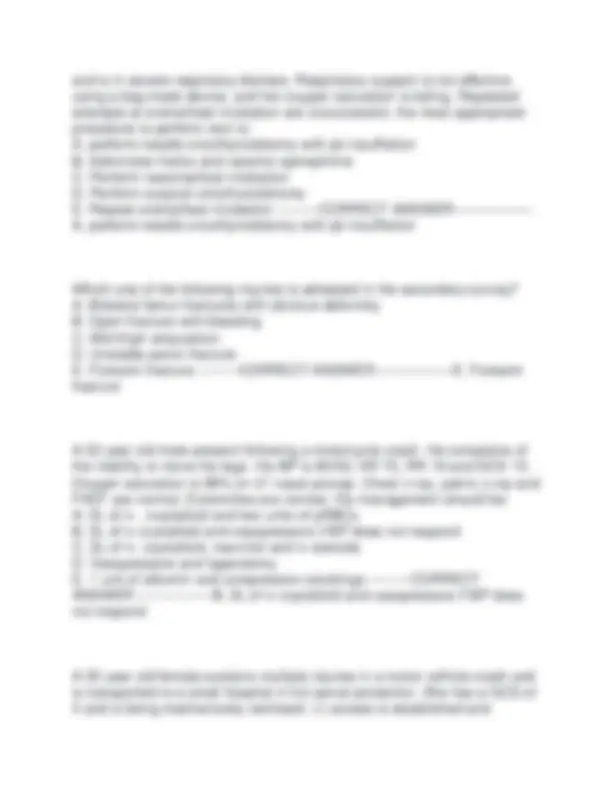
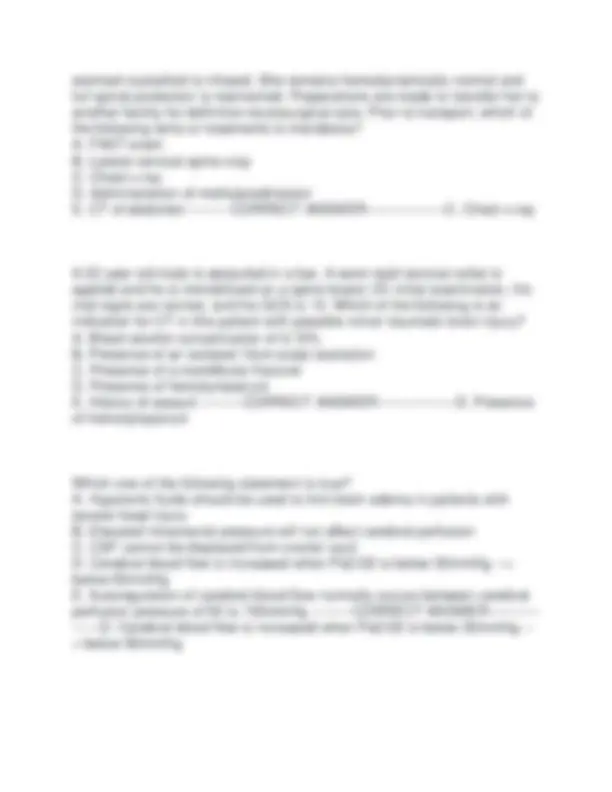
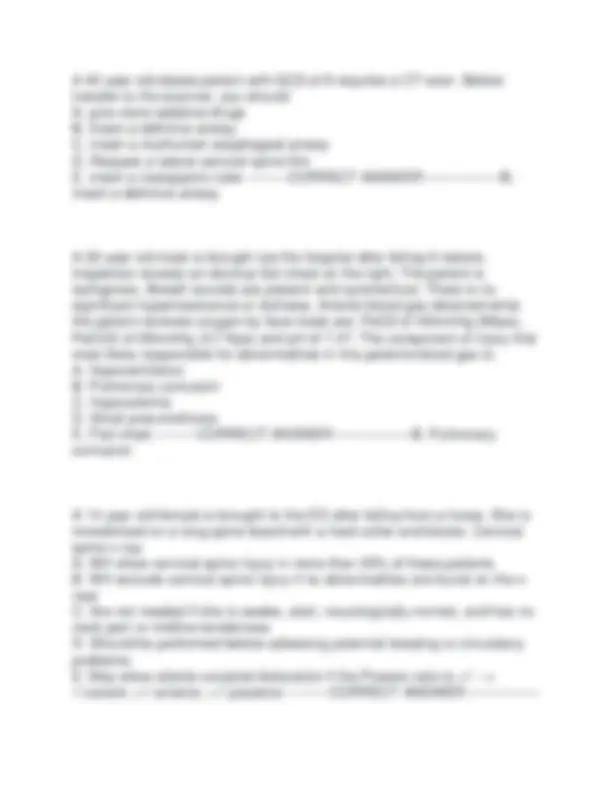
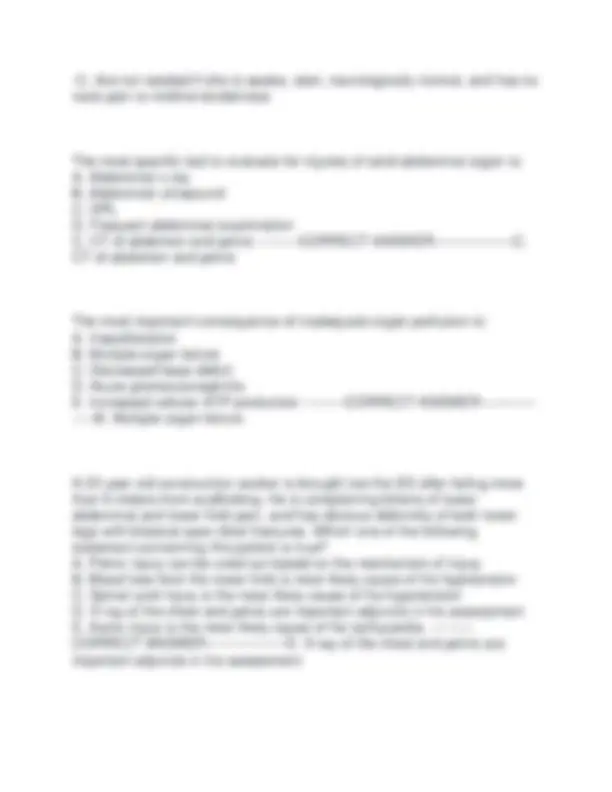
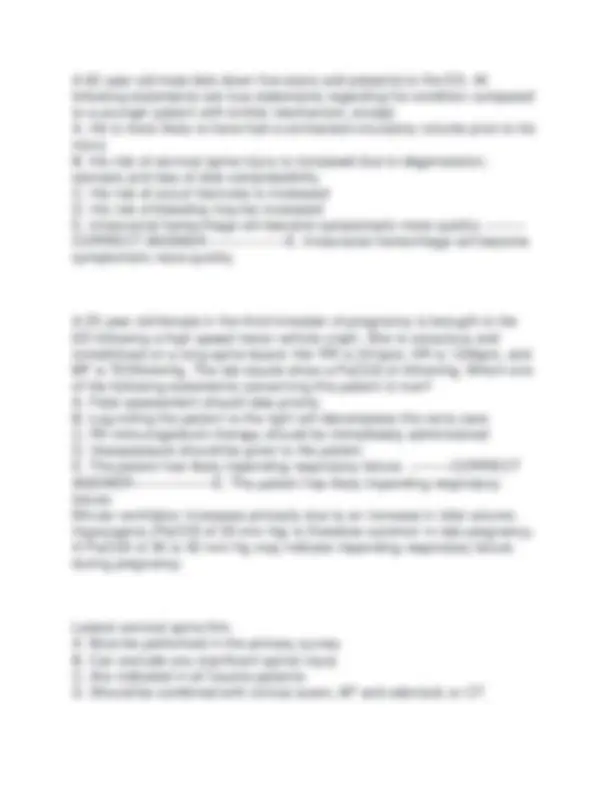
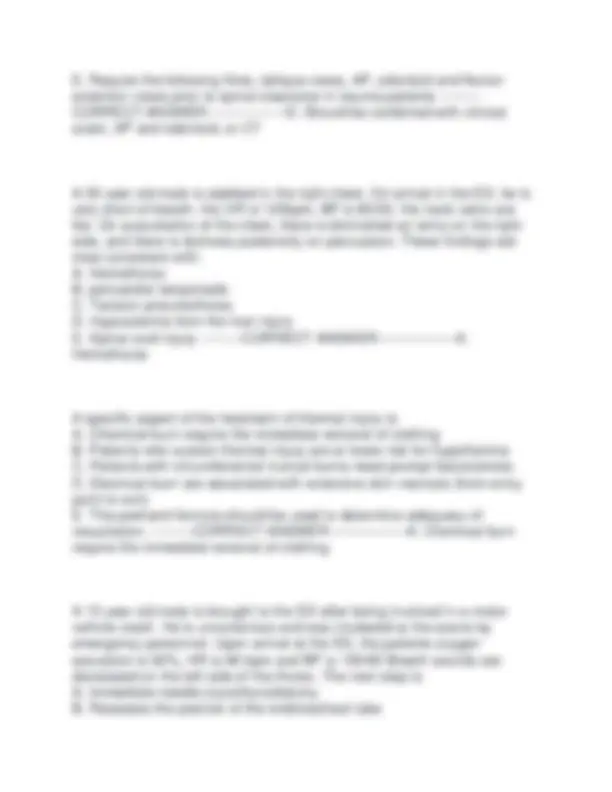
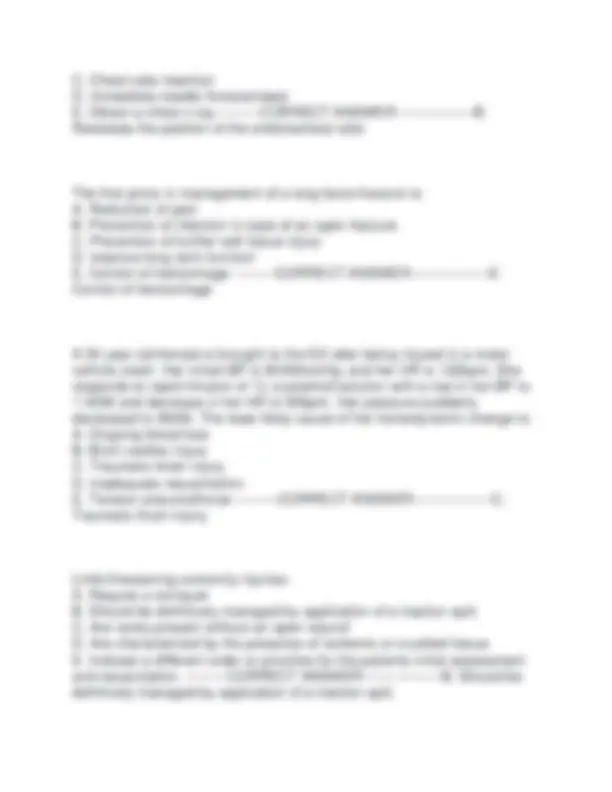
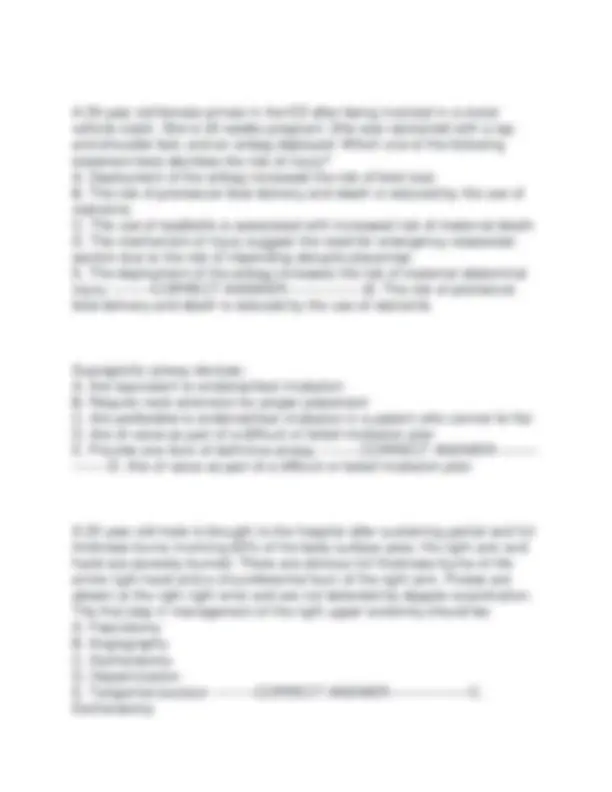
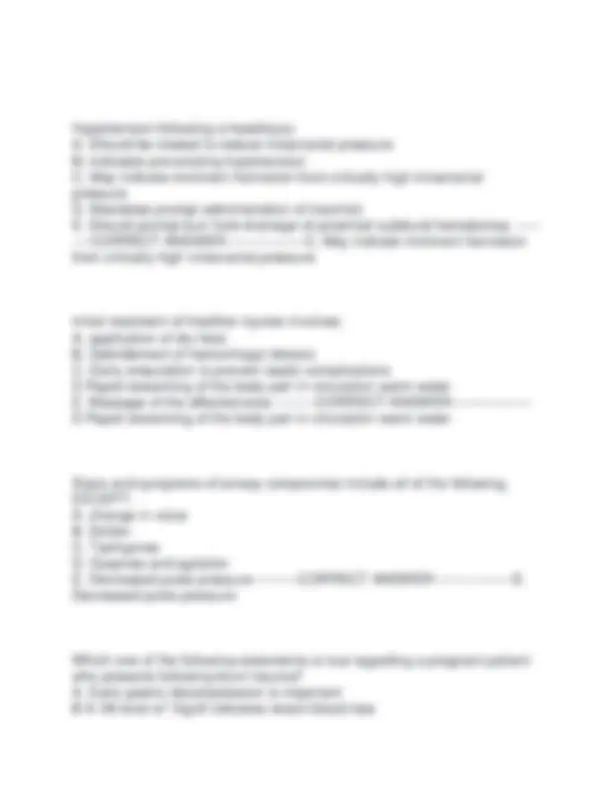
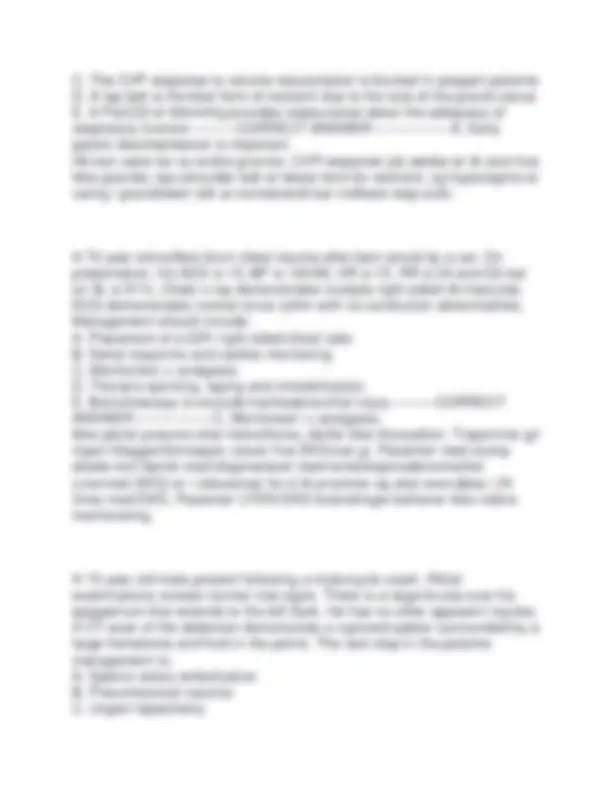
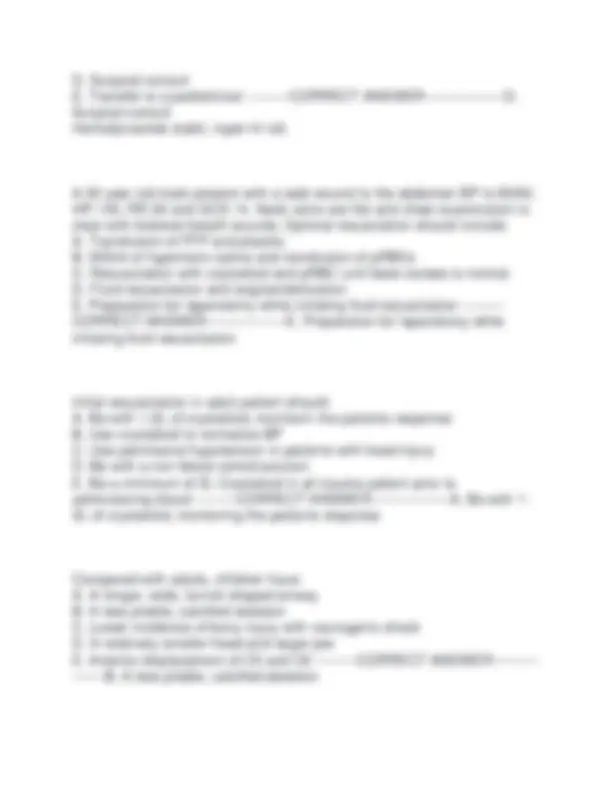
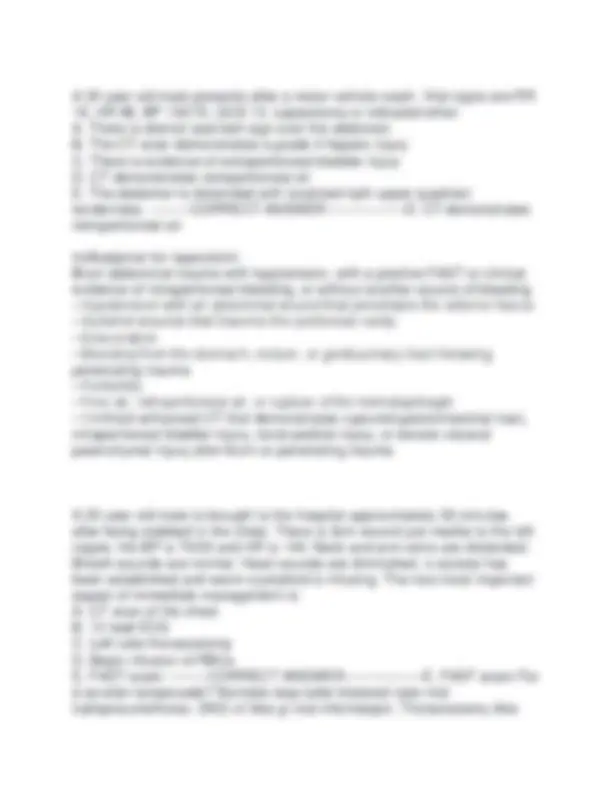
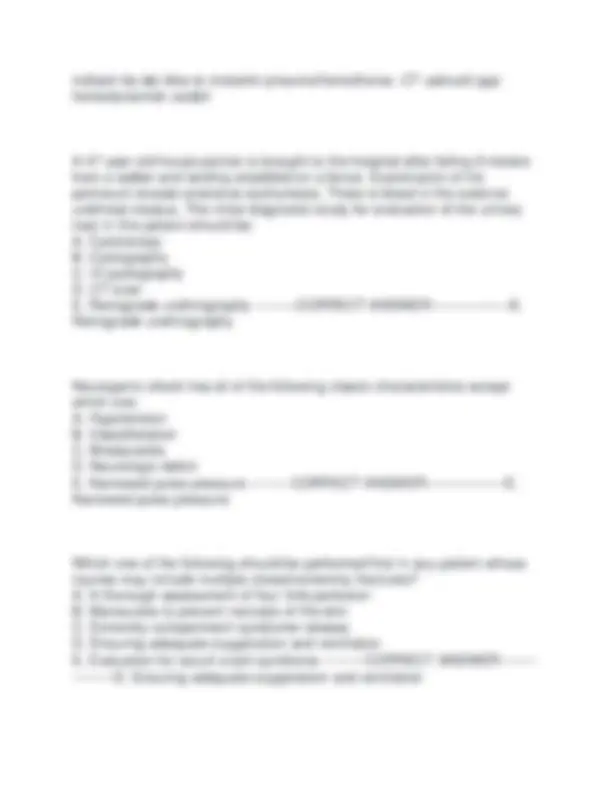


Study with the several resources on Docsity

Earn points by helping other students or get them with a premium plan


Prepare for your exams
Study with the several resources on Docsity

Earn points to download
Earn points by helping other students or get them with a premium plan
Community
Ask the community for help and clear up your study doubts
Discover the best universities in your country according to Docsity users
Free resources
Download our free guides on studying techniques, anxiety management strategies, and thesis advice from Docsity tutors
ATLS EXAM | ADVANCED TRAUMA LIFE SUPPORT EXAM | ALL QUESTIONS AND CORRECT ANSWERS | ALREADY GRADED A+ | VERIFIED ANSWERS | LATEST VERSION 2025
Typology: Exams
1 / 58

This page cannot be seen from the preview
Don't miss anything!



















































A 64-year-old man, involved in a high-speed car crash, is resuscitated initially in a small hospital with limited resources. He has a closed head injury with a GCS score of 13. He has a widened mediastinum on chest x- ray with fractures of left ribs 2 through 4 but no pneumothorax. After infusing 2 liters of crystalloid solution, his blood pressure is 100/74, heart rate is 110 beats per minute, and respiratory rate is 18 breaths per minute. He has gross hematuria and a pelvic fracture. You decide to transfer this patient to a facility capable of providing a higher level of care. The facility is 128km (80 miles) away. Before transfer, you should first: A. Intubate the patient B. Perform diagnostic peritoneal lavage C. Apply the pneumatic antishock garment D. Call the receiving hospital and speak to the surgeon on call E. Discuss the advisability of transfer with the patients family. --------- CORRECT ANSWER-----------------D. Call the receiving hospital and speak to the surgeon on call During the third trimester of pregnancy, all of the following changes occur normally, EXCEPT a: A. Decrease in PaCO B. Decrease in the leukocyte count C. Reduce gastric emptying rate D. Diminished residual lung volume E. Diminished pelvic ligament tension ---------CORRECT ANSWER----------- ------B. Decrease in the leukocyte count In managing the head-injury patient, the most important initial step is to: A. Secure the airway
B. Obtain c-spine film C. Support the circulation D. Control scalp hemorrhage E. Determine GCS score ---------CORRECT ANSWER-----------------A. Secure the airway The first maneuver to improve oxygenation after chest injury is: A. Intubate the patient B. Assess arterial blood gases C. Administer supplemental oxygen D. Ascertain the need for a chest tube E. Obtain a chest x-ray ---------CORRECT ANSWER-----------------C. Administer supplemental oxygen A 25-year-old man, injured in a motor vehicular crash, is admitted to the ED. His pupils react sluggishly and his eyes open to painful stimuli only. He does not follow commands, but he does moan periodically. His right arm is deformed and does not respond to painful stimulus; however, his left hand reaches purposefully toward the painful stimulus. Both legs are stiffly extended. His GCS score is: A. 7 B. 8 C. 9 D. 10 E. 11 ---------CORRECT ANSWER----------------- 9 A 20-year-old woman, at 32 weeks gestation, is stabbed in the upper right chest. In the ED, her blood pressure is 80/60mmHg. She is gasping for breath, extremely anxious, and yelling for help. Breath sounds are diminished in the right chest. The most appropriate first step is to: A. perform tracheal intubation B. Insert an oropharyngeal airway C. Perform needle decompression of the right chest D. Manually displace the gravid uterus to the left side of the abdomen
A 60-year-old man sustains a stab wound to the right posterior flank. Witnesses state the weapon was a small knife. His heart rate is 90 beats per minute, blood pressure is 128/72mmHg and respiratory rate is 24 breaths per minute. The most appropriate action to take at this time is to: A. Perform a colonoscopy B. Perform a barium enema C. Perform an intravenous pyelogram D. Perform serial physical examinations E. Suture repair the wound and outpatient follow up ---------CORRECT ANSWER-----------------D. Perform serial physical examinations The following are criteria for transfer to a burn center, EXCEPT for: A. Partial-thickness and full-thickness burns on greater than 10% of the BSA B. Any full-thickness burn C. Partial-thickness and full-thickness burn involving the face, hands, feet, genitalia, perineum and skin overlying major joints D. Elevated central venous pressure E. Inhalation injury ---------CORRECT ANSWER-----------------D. Elevated central venous pressure Systolic blood pressure starts to decrease in which class of hemorrhage? A. Class 0 B. Class 1 C. Class 2 D. Class 3 E. Class 4 ---------CORRECT ANSWER-----------------C. Class 2 A 7-year-old boy is brought to the ED by his parents several minutes after he fell through a window. He is bleeding profusely from a 6-cm wound of his medial right thigh. Immediate management of the wound should consist of:
A. Application of a torniquet B. Direct pressure on the wound C. Packing the wound with gauze D. Direct pressure on the femoral artery at the groin E. Debridement of devitalized tissue ---------CORRECT ANSWER------------- ----B. Direct pressure on the wound For the patient with severe traumatic brain injury, profound hypocarbia should be avoided to prevent: A. Respiratory alkalosis B. Metabolic acidosis C. Cerebral vasoconstriction with diminished perfusion D. Neurogenic pulmonary edema E. Shift of the oxyhemoglobin dissociation curve. ---------CORRECT ANSWER-----------------C. Cerebral vasoconstriction with diminished perfusion A 33-year-old woman is involved in a head-on motor vehicle crash. It took 30 minutes to extricate her from the car. Upon arrival in the ED, her heart rate is 120 beats per minute, BP is 90/70mmHg, respiratory rate is 16 breaths per minute, and GCS is 15. Examination reveals bilaterally equal breath sounds, anterior chest wall ecchymosis, and distended neck veins. Her abdomen is flat, soft, and not tender. Her pelvis is stable. Palpable distal pulses are found in all 4 extremities. Of the following, the most likely diagnosis is: A. hemorrhagic shock B. Cardiac tamponade C. Massive hemothorax D. Tension pneumothorax E. Diaphragmatic rupture. ---------CORRECT ANSWER-----------------B. Cardiac tamponade A hemodynamically normal 10-year-old girls is admitted to the pediatric intensive care unit for observation after a grade III (moderately severe)
C. Intraosseous infusion is the preferred route for volume resuscitation in small children D. Intraosseous infusion may be utilized indefinitely E. Swelling in the soft tissues around the intraosseous site is not a reason to discontinue infusion. ---------CORRECT ANSWER-----------------B. Aspiration of bone marrow confirms appropriate positioning of the needle The most important, immediate step in the management of an open pneumothorax is: A. endotracheal intubation B. Operation to close the wound C. Placing a chest tube through the chest wound D. Placement of an occlusive dressing over the wound E. Initiation of 2 large-caliber IVs with crystalloid solution ---------CORRECT ANSWER-----------------D. Placement of an occlusive dressing over the wound Which one of the following situations requires Rh immunoglobulin administration to an injured woman? A. Negative pregnancy test, Rh negative, and torso trauma B. Positive pregnancy test, Rh positive, and has torso trauma C. Positive pregnancy test, Rh negative, and has torso trauma D. Positive pregnancy test, Rh positive, and has an isolated wrist fracture E. Positive pregnancy test, Rh negative, and has an isolated wrist fracture - --------CORRECT ANSWER-----------------C. Positive pregnancy test, Rh negative, and has torso trauma A 22-year-old man is hypotensive and tachycardic after a shotgun wound to the left shoulder. His BP is initially 80/40mmHg. After 2 liters of crystalloid solution his blood pressure increases to 122/84mmHg. His heart rate is now 100 beats per minute and his respiratory rate is 28 breaths per minute. His breath sounds are decreased in the left hemithorax, and after initial IV fluid resusciation, a closed tube thoracostomy is performed for decreased
left breath sound with the return of small amount of blood and no air leak. After chest tube insertion, the most appropriate next step is to: A. Reexamine the chest B. Perform an aortogram C. Obtain a CT-scan of the chest D. Obtain arterial blood gas analyses E. Perform transesophageal echocardiography ---------CORRECT ANSWER-----------------A. Reexamine the chest A construction worker falls two stories from a building and sustain bilateral calcaneal fractures. In the ED, he is alert, vital signs are normal, and he is complaining of severe pain in both heels and his lower back. Lower extremity pulses are strong and there is no deformity. The suspected diagnosis is most likely to be confirmed by: A. Angiography B. Compartment pressures C. Retrograde urethrogram D. Doppler-ultrasound studies E. Complete spine x-ray series ---------CORRECT ANSWER-----------------E. Complete spine x-ray series A 22-year-old female athlete is stabbed in her left chest at the third interspace in the anterior axillary line. On admission to the ED and 15 minutes after the incident, she is awake and alert. Her heart rate is 100 beats per minute, BP 80/60mmHg, and respiratory rate is 20 breaths per minute. A chest x-ray reveals a large left hemithorax. A left chest tube is placed with an immediate return of 1600ml of blood. The next management step for this patient is: A. perform a thoracoscopy B. Perform an arch aortogram C. Insert a second left chest tube D. Prepare for an exploratory thoracotomy E. Perform a chest CT ---------CORRECT ANSWER-----------------D. Prepare for an exploratory thoracotomy
E. Immediately transfer the patient to a trauma center. ---------CORRECT ANSWER-----------------D. Urgently transfer the patient to the operating room Which of the following signs is LEAST reliable for diagnosing esophageal intubation? A. Symmetrical chest movement B. End-tidal CO2 presence by colorimetry C. Bilateral breath sounds D. Oxygen saturation > 92% E. ETT above carina on chest x-ray ---------CORRECT ANSWER-------------- ---E. ETT above carina on chest x-ray Which one of the following signs necessitates a definitive airway in severe trauma patients? A. Facial lacerations B. Repeated vomiting C. Severe maxillofacial fractures D. Sternal fracture E. GCS score of 12 ---------CORRECT ANSWER-----------------C. Severe maxillofacial fractures Which one of the following statements is correct? A. Cerebral contusion may coalesce to form an intracerebral hematoma B. Epidural hematomas are usually seen in frontal region C. Subdural hematomas are caused by injury to the middle meningeal artery D. Subdural hematomas typically have a lenticular shape on CTscan E. The associated brain damage is more severe in epidural hematomas. --- ------CORRECT ANSWER-----------------A. Cerebral contusion may coalesce to form an intracerebral hematoma
An 18 year old male is brought to the ED after having been shot. He has one bullet wound just below the right clavicle and another just below the costal margin in the right posterior axillary line. His BP is 110/60, HR is 90bpm, and RR is 34bpm. After ensuring a patent airway and inserting 2 large caliber iv line, the next appropriate step is to: A. Obtain a chest x-ray B. Adminster a bolus of additional iv fluid C. Perform a laparotomy D. Obtain abdominal CT-scan E. Perform DPL ---------CORRECT ANSWER-----------------A. Obtain a chest x-ray Which of the following is the recommended Method for trestemt frostbite? A. Vasodilators B. Anticigulants C. Warm (40 degrees) water D. Padding and elevation E. Application of heat from a hairdryer ---------CORRECT ANSWER----------- ------C. Warm (40 degrees) water Which of the following physical findings suggest a cause of hypotension other than spinal cord injury? A. Prispism B. Bradycardia C. Diaphragmatic breathing D. Presence of deep tendon reflexes E. Ability to flex forearms but not extend them ---------CORRECT ANSWER- ----------------D. Presence of deep tendon reflexes. Spinal shock refers to loss of muscle toe (flaccidty) and loss of reflexes. The primary indication for transferring A patient to a higher level trauma center is: A. Unavailibility of surgeon or operating staff B. Multiple system injuries, including severe head injury
A 6-year-o boy is struck by an automobile and brought to the ED. He is lethargic, but withdraws purposefully from painful stimuli. His blood pressure is 90mmHg systolic, heart rate 140 beats per minute and his respiratory rate is 36 breaths per minute. The preferred route of venous access in this patient is: A. Percutaneous femoral vein cannulation B. Cutdown on the saphenous vein at the ankle C. Intraosseous catheter placement in the proximal tibia D. Percutaneous peripheral veins in the upper extremities E. Central venous access via the subclavian or internal jugular vein --------- CORRECT ANSWER-----------------D. Percutaneous peripheral veins in the upper extremities A young man sustains a gunshot wound to the abdomen and is brought promptly to the ED by prehospital personnel. His skin is cool and diaphoretic, and he is confused. His pulse is thready and his femoral pulse is only weakly palpable. The definitive treatment in managing this patient is to: A. Administer O-negative blood B. Apply external warming devices C. Control internal hemorrhage operatively D. Apply a pneumatic antishock garment (PASG) E. Infuse large volumes of intravenous crystalloid solutions. --------- CORRECT ANSWER-----------------C. Control internal hemorrhage operatively Regarding shock in the child, which of the following is FALSE? A. Vital signs are age-related B. Children have greater physiologic reserves than do adults C. Tachycardia is the primary physiologic response to hypovolemia D. The absolute volume of blood loss required to produce shock is the same as in adults E. An initial fluid bolus for resuscitation should approximate 20ml/kg Ringers Lactate ---------CORRECT ANSWER-----------------D. The absolute volume of blood loss required to produce shock is the same as in adults
A 33-year-old man is struck by a car travelling at 56km/h (35mph). He has obvious fractures of the left tibia near the knee, pain in the pelvic area, and severe dyspnea. His heart rate is 182 beats per minute, and his respiratory rate is 48 breaths per minute with no breath sounds heard in the left chest. A tension pneumothorax is relieved by immediate needle decompression and tube thoracostomy. Subsequently, his heart rate decreases to 144 beats per minute, his respirartory rate decreases to 36 breaths per minute and his blood pressure is 81/53 mmHg. Warmed Ringers lactate is adminstered intravenously. The next priority should be to: A. Perform external fixation of the pelvis B. Obtain abdominal and pelvic CT-scans C. Perform arterial embolization of the pelvic vessel D. Perform diagnostic peritoneal lavage or FAST E. Perform a urethrogram and cystogram ---------CORRECT ANSWER------- ----------D. Perform diagnostic peritoneal lavage or FAST A 42-year-old man, injured in a motor vehicle crash, suffers a closed head injury, multiple palpable left rib fractures, and bilateral femur fractures. He is intubated orotracheally without difficulty. Initially, his ventilations are easily assisted with a bag-mask device. It becomes more difficult to ventilate the patient over the next 5 minutes, and his hemoglobin oxygen saturation level decreases from 98% to 89%. The most appropriate next step is to: A. Obtain a chest x-ray B. Decrease the tidal volume C. Decrease PEEP D. Increase the rate of assisted ventilations E. Perform needle decompression of the left chest. ---------CORRECT ANSWER-----------------A. Obtain a chest x-ray (MÅ SJEKKES) A 30-year-old man sustains a severely comminuted, open, distal right femur fracture in a motorcycle crash. The wound is actively bleeding. Normal sensation is present over the lateral aspect of the foot but decreased over the medial foot and great toe. Normal motion of the foot is
The physioclogic hypervolemia of pregnancy has clinical significance in the management of the severely injured gravid woman by A. Reducing the need for blood transfusion B. Increasing the risk of pulmonary edema C. Complicating the management of closed head injury D. Increasing the volume of blood loss to produce shock/maternal hypotension E. Reducing the volume of crystalloid required for resuscitation --------- CORRECT ANSWER-----------------D. Increasing the volume of blood loss to produce shock A 17-year-old helmeted motorcyclist loses consciousness when he is struck broad side by an automobile at an intersection. He arrives in the ED with a blood pressure of 140/92, pulse rate 88 beats per minute, a respiratory rate of 18 breaths per minue, and a GCS of 7. Appropriate initial immobilization of this patient should include a semi-rigid cervical collar and: A. A scoop stretcher B. A long spine board C. A short spine board D. Cervical traction tongs E. Pneumatic antishock garment ---------CORRECT ANSWER----------------- B. A long spine board During an altercation, a 36-year-old man sustains a gunshot wound above the nipple line on the right, with an exit wound posteriorly above the scapula on the right. He is transported by ambulance to a community hospital. He is endotracheally intubated, close tube thoracostomy is performed, and 2 liters Ringers lactate solution are infused via 2 large- caliber IV´s. His blood pressure now is 60/0mmHg, heart rate is 160 beats per minute, and respiratory rate is 14 breaths per minute (ventilated with 100% O2). The most appropriate next step in managin this patient is: A. Laparotomy B. Diagnostic peritoneal lavage C. Arterial blood gas determination D. Administer packed red blood cells
E. Chest X-ray to confirm tube placement ---------CORRECT ANSWER------ -----------E. Chest X-ray to confirm tube placement Abscence of breath sounds and dullness to percussion over the left hemithorax are findings best explained by: A. Left hemothorax B. Cardiac contusion C. Left simple pneumothorax D. Left diaphragmatic rupture E. Right tension pneumothorax ---------CORRECT ANSWER-----------------A. Left hemothorax A 23-year-old man is brought immediately to the ED from the hospitals parking lot where he was shot in the lower abdomen. Examination reveals a single bullet wound. He is breathing and has a thready pulse. However, he is unconsious and has no detectable blood pressure. Optimale immediate management is to: A. Perform a diagnostic peritoneal lavage B. Initiate infusion of packed red blood cells C. Insert a nasogastric tube and urinary catheter D. Transfer the patient to the operating room, while initiating fluid therapy E. Initiate fluid therapy to return his blood pressure to normotensive --------- CORRECT ANSWER-----------------D. Transfer the patient to the operating room, while initiating fluid therapy A teen-aged bicycle rider is hit by a truck traveling at high speed. In the ED, she is actively bleeding from open fractures of her legs, and has abrasions on her chest and abdominal wall. Her blood pressure is 80/50 mmHg, heart rate is 140 beats per minute, respiratory rate is 8 breaths per minute, and GCS score is 6. The first step in managing this patient is to: A. Obtain a lateral cervical spine x-ray B. Insert av central venous pressure line C. Adminster 2 liters of crystalloid solution D. Perform endotracheal intubation and ventilation
breaths per minute. His respirations are sonorous and deep. His GCS score is 6. Immobilization of the entire patient may include the use of all the following EXCEPT: A. Air splints B. Bolstering devices C. A long spine board D. A scoop-style stretcher E. A semi-rigid cervical collar ---------CORRECT ANSWER-----------------A. Air splints Twenty-seven patients are seriously injured in an aircraft accident at a local airport. The basic principle of triage should be to: A. Treat the most severely injured patients first B. Establish a field triage area directed by a doctor C. Rapidly transport all patients to the nearest appropriate hospital D. Treat the greatest number of patients in the shortest period of time E. Produce the greatest number of survivors based on available resources ---------CORRECT ANSWER-----------------E. Produce the greatest number of survivors based on available resources An electrician is eletrocuted by a downed power line after a thunderstorm. He apparently made contact with the wire at the level of the right mid thigh. In the ED, his vital signs are normal and no dysrythmia is noted on ECG. On examination, there is an exit wound on the bottom of the right foot. His urine is positive for blood by dipstick but not RBCs are seen microscopically. Initial management should include: A. Immediate angiography B. Aggressive fluid infusion C. Intravenous pyelography D. Debridement of necrotic muscle E. Admission to the ICU for observation ---------CORRECT ANSWER--------- --------B. Aggressive fluid infusion - suspected rhabdomyolyse
A young woman sustains a severe head injury as the result of a motor vehicular crash. In the ED, her GCS is 6. Her blood pressure is 140/ mmHg and her heart rate 80 beats per minute. She is intubated and is being mechanically ventilated. Her pupils are 3mm in size and equally reactive to light. There is no other apparent injury. The most important principle to follow in early management of her head injury is to: A. Administer an osmotic diuretic B. Prevent secondary brain injury C. Agressively treat systemic hypertension D. Reduce meatbolic requirements of the brain E. Distinguish between intracranial hematoma and cerebral edema. --------- CORRECT ANSWER-----------------B. Prevent secondary brain injury To establish a diagnosis of shock, A. Systolic blood pressure must be below 90mmHg B. The presence of a closed head injury should be excluded C. Acidosis should be present by arterial blood gas analysis D. The patient must fail to respond to intravenous fluid infusion E. Clinical evidence of inadequate organ perfusion must be present. --------- CORRECT ANSWER-----------------E. Clinical evidence of inadequate organ perfusion must be present. A 32-year-old is brought to the hospital unconscious with severe facial injuries and noisy respirations after an automobile collision. In the ED, he has no apparent injury to the anterior aspect of his neck. He suddenly becomes apneic, and attempted ventilation with a face mask is unsuccessful. Examination of his mouth reveals a large hematoma of the pharynx with loss of normal anatomic landmarks. Initial management of his airways should be consist of: A. Inserting an oropharyngeal airway B. Inserting a nasopharyngeal airway C. Performing a surgical cricothyroidotomy D. Performing fiberoptic-guided nasotracheal intubation E. Performin orotracheal intubation after obtaining a lateral c-spine x-ray --- ------CORRECT ANSWER-----------------A. Inserting an oropharyngeal airway